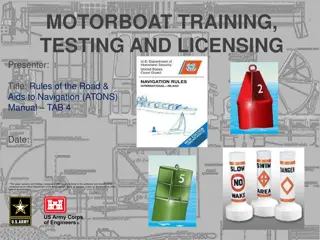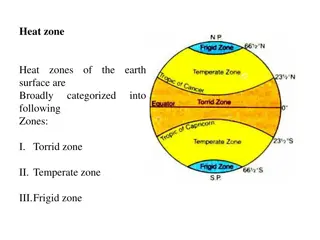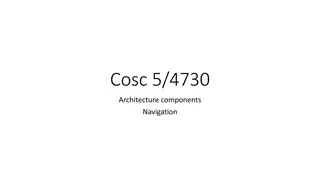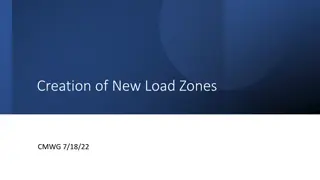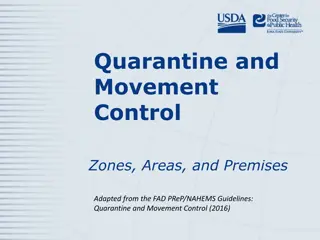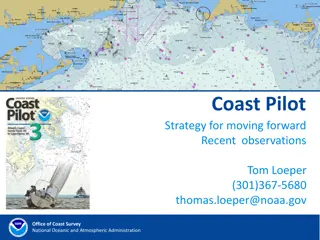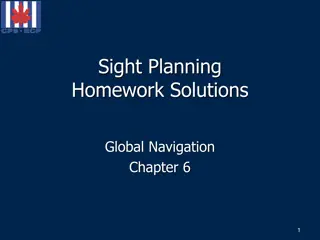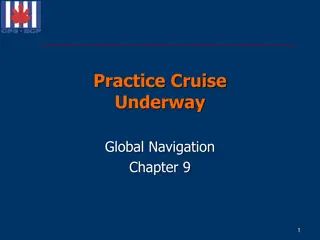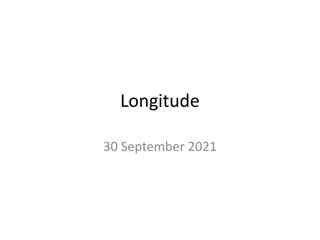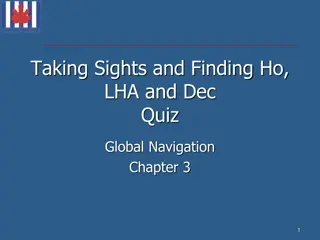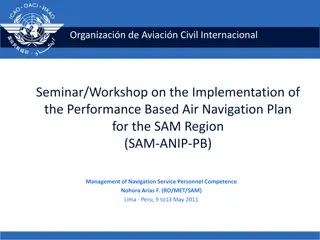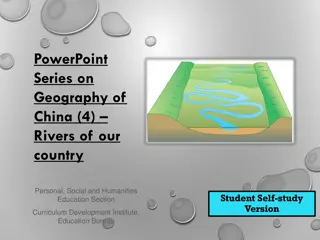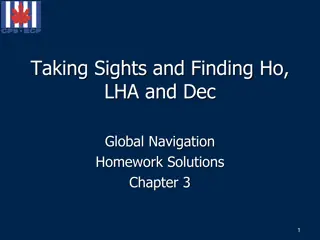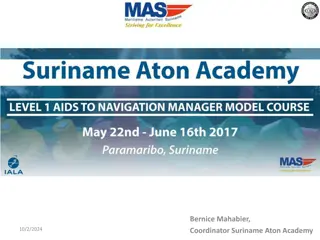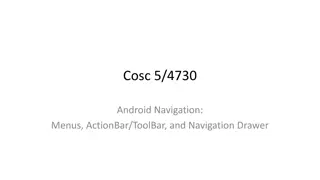Understanding Time Zones and Celestial Observations for Navigation
Explore the concepts of local mean time and zone time, and learn how to convert between them. Discover how to determine the ZT of sunrise, sunset, moonrise, and twilight phases using the Nautical Almanac. Practice answering questions related to observational timings and positional calculations.
Download Presentation

Please find below an Image/Link to download the presentation.
The content on the website is provided AS IS for your information and personal use only. It may not be sold, licensed, or shared on other websites without obtaining consent from the author. Download presentation by click this link. If you encounter any issues during the download, it is possible that the publisher has removed the file from their server.
E N D
Presentation Transcript
Sunrise Sunset Global Navigation Homework Solutions Chapter 2 1
Objectives Understand the difference between local mean time and zone time and how to convert from one to the other. Determine the ZT of sunrise, sunset, moonrise and civil and nautical twilight from the Nautical Almanac 2
Question 1 The earliest time you can begin sextant observations in the morning is usually: A. Shortly after the beginning of nautical twiliglight. B. Shortly after the end od nautical twilight. C. Shortly after the beginning of civil twilight. D. Shortly after the end of civil twilight. Ref: 14 3
Question 2 The midpoint of the optimum observing time in the evening is usually around: A. The beginning of nautical twilight. B. The end of nautical twilight. C. The beginning of civil twilight. D. The end of civil twilight. Ref: 14 4
Question 3 If you are west of a zone meridian in east longitude, to convert LMT to ZT you would: A. Add ZD B. Subtract ZD C. Add Dlo W (converted to time) D. Subtract DLo E (converted to time) Ref: 25 5
Question 4 Solution 4 a LMT SS 1811 1811 0 LMT CT 1835 1836 +1 sec, rounded to 9 min LMT CT 1836 + 9 1845 L30 S L35 S 5 Determine the ZT of sunset and the end of evening civil twilight for the following dates and positions: A. 20 March L34 26,8 S Lo047 12,6 W B. 30 June L29 14,0 N Lo158 47,9 W L30 S 1811 Corr. 0 L34 26,8 S 1811 Solution4 a (continued) ZD +3, ZM Lo045 , DLo 2 12,6 X 4 = 8 min 50,4 Diff L34 26,8 S L30 S = 4 26,8 = 4.45 Corr: 0 LMT 1811 Dlo (W) ZT LMT SS (4,45 5) X 1 = 0,9 rounded to 1 min 1835 + 1 1836 + 9 1820 6
Question 4 b - solution LMT SS L30 N 1905 L20 N 1843 10 +22 L29 14,0 N L20 N = 9 14,0 = 9,23 Corr: (9,23 10) X 22 = 20 min. (9,23 10) X 25 = 23 min. L20 1843 Corr. + 20 L29 14,0 1903 LMT CT 1933 1908 +25 LMT CT 1931 -25 1906 ZD -11, ZM 165 W, DLo 6 12,1 E X 4 = 24 min 48,4 sec., rounded to 25 min. LMT SS LMT 1903 DLo (E) -25 ZT 1838 Diff 1908 +23 1931 7
Question 5 LMT Moonrise b) b) LMT Moonset 0149 0138 - 08 LMT Moonrise LMT Moonset 0149 a) a) L10 N Corr L18 15,1 N L51 32,2 S LMT Moonrise 0542 - 06 m LMT Moorise 0535 0542 -07 min 0536 LMT Moonset 1826 1817 + 9 m 1824 LMT Moonset 1817 + 07 m -11 0141 Determine the ZT of moonrise et moonset for the following dates and positions : A) 19 April L18 15,1 N Lo139 06,5 E B) 24 Dec L51 32,2 S, Lo006 12,8 w L18 15,1 N L10 N = 8 15,1 = 8,255 Corr: (8,25 10) x 7 = 5,7, or 6, min (8,25 10) X 9 = 7,4, or 7,min LMT 0536 DLo (E) -16 ZT 0520 ZT L50 S L52 S Diff 2 1852 1905 + 13 1902 L50 S Corr 1852 +10 L20 N L10 N Diff 10 L51 32,2 S L50 S = 1 32,2 = 1,54 Corr (1,54 2) X 13 = 10 min 24 min, 51 sec, rounded to 25 minutes. ZD +0, ZM 0 , DLo 6 12,8 W X 4 = ZD +9, ZM Lo135 W, DLo 4 06,5 E X 4 = 16 min, 26 sec, rounded to 16 minutes. (1,54 2) X 11 = 8,47, or 8 minutes LMT DLo (W) 0141 + 25 0206 1902 + 25 1927 1824 - 16 1808 8
Question 6 From the Almanac, the LMT of CT for L40 N on that date is 1922. Using this as CT, extend the intended track and measure the coordinates of the projected position for 1922. The plot places the DR of the 1922 position at L38 55,8 N, ZD -10, ZM 150 E, DLo 5 04,0 E X 4 = 20min 16 sec, rounded to 20 minutes LMT DLo (W) +20 ZT On 17 August, the 1500 GPS position of a vessel is L39 10 N, Lo144 06 E. Course is 110 T, and speed is 9,5 knots. The current is negligible. Determine the ZT of evening CT. Lo144 56,0 E. L40 N L35 N Diff 5 L38 55,8 N L35 N = 3 55,8 = 3,93 Corr (3,93 5) X 10 = 7,86, or 8, min L35 N L38 55,8 L38 55,8 N 1912 + 8 m 1920 Corr 1922 1912 + 10 m 1940 1920 9
Sunrise Sunset End of Chapter 2 10




